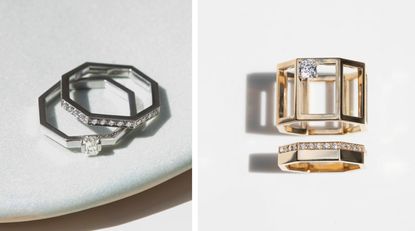The diamond industry has witnessed a major transformation in recent years with the emergence of lab diamonds, also known as man-made diamonds. These diamonds have been gaining popularity due to their ethical and environmental benefits, as well as their affordable pricing. In this article, we will explore the concept of lab diamonds, their cultural significance, and why they are becoming a preferred choice for many consumers around the world.
Table of Contents
ToggleWhat Are Cultures and Lab Diamonds?
Cultures and lab diamonds, also referred to as man-made diamonds, are diamonds that are created in controlled laboratory environments, replicating the conditions found deep within the Earth. Unlike natural diamonds, which are formed over millions of years under extreme pressure and temperature, lab diamonds are produced in a matter of weeks. This process involves using either High Pressure High Temperature (HPHT) or Chemical Vapor Deposition (CVD) methods to grow diamonds that are chemically and physically identical to those found in nature.
Lab diamonds are often seen as a more sustainable and ethical alternative to mined diamonds, as they avoid the environmental destruction and exploitation of labor often associated with traditional diamond mining practices. Moreover, lab-grown diamonds are often priced lower than their natural counterparts, making them a more accessible option for consumers seeking the beauty and quality of diamonds without the hefty price tag.
The Cultural Significance of Lab Diamonds
The cultural significance of lab diamonds is increasingly becoming a focal point in modern society. With growing concerns over the ethical and environmental impact of traditional diamond mining, many individuals and communities are turning to lab diamonds as a solution. Cultures and lab diamonds resonate with a younger, more socially conscious generation that values sustainability and ethical sourcing.
In various cultures, diamonds have long been symbols of love, commitment, and status. With lab diamonds offering a more sustainable and affordable alternative, people are embracing them for engagements, weddings, and other significant life events. The cultural shift toward lab diamonds reflects a growing awareness of environmental issues and a desire for greater transparency in the products people purchase.
The Environmental Benefits of Lab Diamonds
One of the primary advantages of lab diamonds is their positive impact on the environment. Unlike traditional diamond mining, which can lead to significant environmental destruction, such as deforestation and soil erosion, lab-grown diamonds are produced with minimal environmental disruption. This makes them an attractive choice for consumers who are concerned about the ecological impact of their purchases.
In addition to reducing environmental harm, cultures and lab diamonds also contribute to lowering carbon emissions. The process of creating these diamonds requires far less energy and natural resources than mining and processing natural diamonds. As a result, the environmental footprint of lab-grown diamonds is significantly smaller, making them an eco-friendly option for consumers who want to make a more responsible choice.
The Quality of Lab Diamonds
Another compelling reason why lab diamonds are gaining traction is the high-quality standards they adhere to. Cultures and lab diamonds are virtually indistinguishable from mined diamonds to the naked eye, and they possess the same chemical, optical, and physical properties. Both types of diamonds are made of pure carbon atoms arranged in a crystal lattice structure, which gives them their characteristic brilliance and hardness.
The only difference between a lab diamond and a mined diamond is their origin. As a result, lab diamonds have the same durability and longevity as natural diamonds. They can withstand the same level of wear and tear, making them a perfect choice for engagement rings, wedding bands, and other fine jewelry pieces.
Lab Diamonds and Their Affordability
Affordability is one of the key reasons why many people are choosing man made diamonds over traditional mined diamonds. Cultures and lab diamonds are typically 30-40% less expensive than their natural counterparts, making them an attractive option for budget-conscious consumers. The cost savings can be used to invest in larger diamonds or more intricate jewelry designs, providing greater value for money.
The affordability of lab diamonds also allows consumers to choose ethically sourced diamonds without compromising on quality or size. For those who are seeking an alternative to the high price of natural diamonds, lab diamonds offer an affordable solution that does not sacrifice beauty or durability.
The Future of Lab Diamonds in Global Cultures
The future of lab diamonds is bright, with an increasing number of consumers, retailers, and even celebrities embracing the benefits of man-made diamonds. Cultures and lab diamonds are likely to play an even larger role in shaping the diamond industry in the years to come. As technology advances and lab-grown diamonds become even more widely available, the demand for these sustainable and ethical alternatives to natural diamonds will continue to grow.
The cultural shift toward lab diamonds reflects a broader trend toward conscious consumerism, where people are increasingly prioritizing sustainability, ethics, and transparency in their purchasing decisions. This movement is reshaping not only the diamond industry but also the way we view luxury products and their impact on the world around us.
Conclusion
In conclusion, cultures and lab diamonds represent a revolutionary change in the diamond industry, offering a more ethical, sustainable, and affordable option for consumers. These man-made diamonds are gaining popularity for their identical quality to natural diamonds, their positive environmental impact, and their cultural significance. As lab diamonds continue to rise in prominence, they are set to redefine the future of the diamond industry and become an integral part of global cultures for generations to come.

